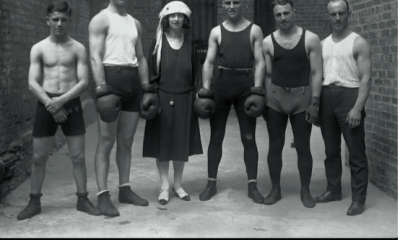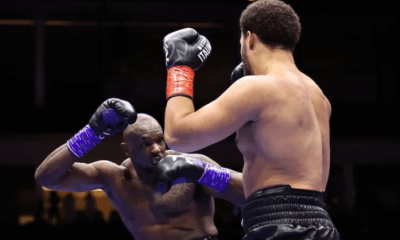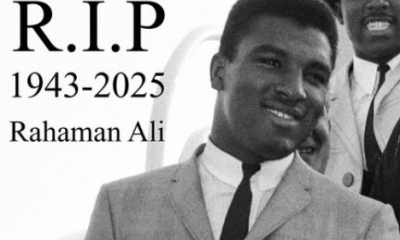Featured Articles
The Year 1976 Was The Ultimate Boxing Convergence
On March 24th 1975, Muhammad Ali made the first defense of his undisputed heavyweight title against 6-5, 230 pound journeyman Chuck Wepner. Five months earlier Ali won the title for the second time by knocking out undefeated George Foreman in the eighth round. Wepner (30-9-2) was a tough guy but certainly wasn’t expected to give Ali (45-2) much trouble as the 10-1 odds against him indicated. Well, Wepner’s awkwardness and rabbit punching bothered Ali, and in the ninth round he scored a flash knockdown of Ali. Ali dominated the fight after that, finally finishing Wepner at 2:41 of the 15th round. Wepner’s inspired performance struck a nerve with an unknown struggling actor named Sylvester Stallone who was watching the fight on closed circuit in a Los Angeles theater. When Stallone got home that night he wrote a script for a movie about a down-and-out heavyweight fighter and titled it “Rocky.” More on that later.
By January of 1976, Ali had made four successful defenses of the title he won from George Foreman in October of 1974. Ali’s popularity was soaring at this time and boxing was on network television almost every weekend. On Saturday afternoon, January 24, 1976, Foreman fought on ABC Wide World of sports for the first time since losing his undefeated record and title to Ali. Foreman’s opponent, Ron Lyle, was another big heavyweight who could really punch with both hands. Eight months earlier Lyle had been stopped by Ali in the 11th round in the only title shot of his career. Both Foreman (40-1) and Lyle (31-3-1) viewed their fight as a crossroad bout; in order for either of them to get another shot at Ali and the title, they had to win. Prior to fighting Ali, Foreman intimidated his opponents and usually had their heart before he threw a single punch. However, Ron Lyle didn’t scare easily and looked Foreman directly in the eye at center ring with sheer disdain during the referee’s final instructions. As expected, the fight was a dockside brawl.
During the first round, Lyle, who was boxing in retreat, shook Foreman right at the bell to end the round. Foreman came on strong in the second round and shook Lyle real good despite the round only being two minutes long. In the third round Foreman and Lyle exchanged bombs but neither could put much hurt on the other. However, Foreman looked to be the more tired of the two. Early in the fourth round Lyle dropped Foreman with a left-hook-right hand combination and looked to be gaining the upper hand. But as Howard Cosell said during his call of the fight, Foreman struck back and dropped Lyle with a chopping right hand.
Lyle beat the count and with a minute to go in the round Foreman tried to finish him. George had Lyle against the ropes and was pot-shooting him with jabs, right hands and left hooks with Lyle only punching back sporadically. Then Lyle came back out of nowhere and staggered Foreman with short left hooks and right hands, and then dropped him face first with a right hand. Foreman struggled to beat the count and staggered back to his corner as the bell sounded to end the round. Early in the fifth Lyle staggered Foreman and just when it looked as if Ron was going to finally put him away, Foreman exploded with a barrage of hay-maker hooks and right hands, battering Lyle into a ring corner and unloading on him. Lyle crumbled to the canvas and there was no need for the referee to count because he was out.
Foreman-Lyle 40 years later is still remembered as one of the most exciting bouts ever. Everyone remembers where they were when they watched it and it was instrumental in starting off 1976 as a banner year in boxing.
Three months later Ali defended his title on ABC the night before the Kentucky Derby. His opponent was third ranked Jimmy Young out of Philadelphia. The fight was a stinker and after 15 rounds Ali retained the title via a controversial unanimous decision. However, between the pre-fight, the bout itself and the post-fight, America was entertained by Muhammad Ali for over two hours on network television on the last Friday night in April of 1976.
Two and a half months after Ali defeated Jimmy Young, the opening ceremonies of the Summer Olympics in Montreal began. The 1976 summer games saw the birth of superstar competitors the likes of decathlete Bruce/Caitlyn Jenner and gymnast Nadia Comaneci. During the 1970s, boxing was one of the marque events during the summer games. At that time boxing was on TV every weekend, or so it seemed. Muhammad Ali was the most recognized person in the world and it just so happened that the United States Olympic boxing team was pretty stout.
During the last two weeks of July 1976, the American boxing team medaled in seven of 11 weight classes. Five of those medals were gold, won by flyweight Leo Randolph, lightweight Howard Davis, light welterweight Sugar Ray Leonard, middleweight Michael Spinks and light heavyweight Leon Spinks. To go along with them, bantamweight Charles Mooney captured a Silver and heavyweight John Tate won a Bronze.
Six of those Olympians (Mooney never turned pro) became household names and began fighting on network television on the weekends starting in early 1977. Sugar Ray Leonard and Michael Spinks went on to become all-time greats at welterweight and light heavyweight. Leo Randolph and John Tate won world titles at super Bantamweight and heavyweight, and less than two years after the games, Leon Spinks upset Muhammad Ali for the undisputed heavyweight title and then lost it back to him six months later. Howard Davis, who was voted the outstanding boxer at the games, failed in three attempts to win the lightweight title as a pro.
On November 21, 1976 the movie “Rocky” premiered in New York City. Sylvester Stallone played the character of Rocky Balboa. In the role inspired by Chuck Wepner, Balboa gets a shot at heavyweight champ and Muhammad Ali clone, Apollo Creed. Like Ali in early 1975, Creed was looking for an easy payday with some sort of a Disney theme for the bout. Prior to the Creed-Balboa fight, former champ Joe Frazier makes a cameo and interacts with Creed in the manner he used to with Ali. And like Wepner, Balboa makes it to the 15th round but instead of being stopped, Rocky loses a split decision. Rocky received ten Oscar nominations in nine categories at the 49th Academy Awards and won best picture.
There has never been a better year in boxing than 1976 where the right things all converged for the final generation in which boxing remained a first-tier sport. Think about all of that. The most popular and most recognized fighter in history, Muhammad Ali, hovering over great fights and great fighters on TV almost every weekend, during an Olympic year with the U.S. team that produced two all-time greats winning five gold medals, followed by the November release of perhaps the most iconic boxing movie ever.
These events brought scores of new fans to boxing and we’ll likely never see anything like the year 1976 again! What a year it was, and the resurgence it ignited in the sport was something boxing rode through the late 1990s.
Frank Lotierzo can be contacted at GlovedFist@Gmail.com
-

 Featured Articles4 weeks ago
Featured Articles4 weeks agoThe Hauser Report: Zayas-Garcia, Pacquiao, Usyk, and the NYSAC
-

 Featured Articles3 weeks ago
Featured Articles3 weeks agoOscar Duarte and Regis Prograis Prevail on an Action-Packed Fight Card in Chicago
-

 Featured Articles3 weeks ago
Featured Articles3 weeks agoThe Hauser Report: Cinematic and Literary Notes
-

 Book Review2 weeks ago
Book Review2 weeks agoMark Kriegel’s New Book About Mike Tyson is a Must-Read
-

 Featured Articles4 days ago
Featured Articles4 days agoThe Hauser Report: Debunking Two Myths and Other Notes
-

 Featured Articles4 weeks ago
Featured Articles4 weeks agoRemembering Dwight Muhammad Qawi (1953-2025) and his Triumphant Return to Prison
-

 Featured Articles1 week ago
Featured Articles1 week agoMoses Itauma Continues his Rapid Rise; Steamrolls Dillian Whyte in Riyadh
-

 Featured Articles3 weeks ago
Featured Articles3 weeks agoRahaman Ali (1943-2025)















